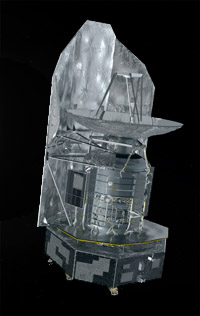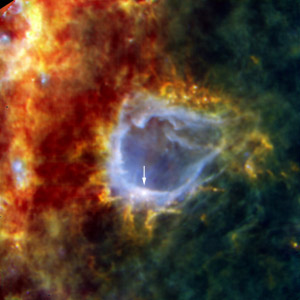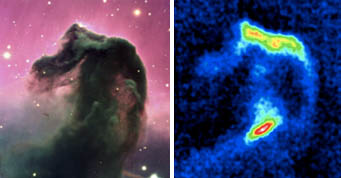A couple of weeks ago we celebrated the Hubble Space Telescope's 20 years of discovery, and today astronomers gathered in Noordwijk, The Netherlands, to recognize another milestone by an up-and-coming space observatory.

Launched on May 14, 2009, the Herschel Space Observatory boasts a primary mirror 3.5 meters across. To view faint far-infrared sources, the spacecraft uses a large Sun shield and liquid helium to keep its optics and detectors cold.
European Space Agency
It's been almost a year since the European Space Agency launched its Herschel Space Observatory, which shared its ride to orbit with the Planck spacecraft. Both payloads are doing well: Planck has been busy compiling the most accurate map ever made of the cosmic microwave background (CMB), the relic radiation from the Big Bang.
But the focus at today's gathering was Herschel and its trove of amazing observations. The spacecraft boasts a mirror 11.5 feet (3.5 m) across, more than twice HST's light-gathering power. But Herschel looks almost exclusively at far-infrared and submillimeter-wave "light," from 55 to 670 microns wavelength. (Visible light is from 0.4 to 0.7 microns.) Such wavelengths show very cold objects "glowing" at only a few tens of degrees above absolute zero. Since a telescope's resolution decreases at long wavelengths, Herschel needs all that aperture to see fine-scale detail in its frigid targets.
It also needs help to keep its own "body heat" from swamping the faint signals from the depths of space. An onboard supply of liquid helium should keep the detectors hovering near absolute zero for another three years. Cooling the primary mirror is another story — it's too big to refrigerate, so it stays hidden behind a Sun shield to remain near -315°F (80 K).
Herschel carries three instruments: a pair of cameras (PACS and SPIRE) and a ultra-high-precision spectrometer (HIFI). The mission's one serious glitch came last August, when HIFI fell silent, but in January controllers switched to a set of backup electronics and it's been working fine since then.

Herschel’s observation of the interstellar bubble RCW 120, about 4,300 light-years away, has revealed an embryonic star in its rim (arrowed) that looks set to turn into one of the brightest, most massive stars in our galaxy. Click here for a larger view.
ESA / PACS / SPIRE / HOBYS Consortia
Today's show-'n'-tell was webcast live, and you can catch an on-demand replay here.
Investigator Annie Zavagno's presentation, "The Dark Side of Star Formation," focused on the little-understood process that spawns beefy stars with at least 8 times the Sun's mass. These heavyweights are rarely found, both because just-forming stars exercise lots of self-control when gobbling up interstellar gas and because they exhaust their hydrogen fuel and die in just a few million years. Zavagno (Laboratoire d’Astrophysique, Marseilles) and her team have used Herschel to spot high-mass stars as they form, and it now seems that the trigger points occur along the margins of rapidly expanding ionized-hydrogen bubbles (called HII regions).
Meanwhile, the recently rejuvenated HIFI spectrometer has been tracking down concentrations of ionized water, which has a distinct and strong spectral signature. "Water is an excellent diagnostic tool to probe the chemical and physical structure of the interstellar medium," explains Alexander Tielens (Leiden University). In particular, he notes, water helps cool the gas and dust surrounding newborn stars by radiating infrared energy to space.

The familiar visible-light view of the Horsehead nebula (left) compared to a far-infrared internal view from the Herschel Space Observatory, which reveals regions of intense star formation. Click here for a larger version.
Steve Eales / Univ. of Cardiff
But what really caught my eye today was a side-by-side comparison of the famed Horsehead Nebula in Orion. it turns out that the dark "clouds" that give this showpiece its distinctive appearance in visible light are internally ablaze with star formation when spied in the far infrared. Steve Eales (University of Cardiff) showed the paired views to demonstrate the potential of the Herschel ATLAS (short for Astrophysical Terahertz Large Area Survey), which will map 550 square degrees of sky at five wavelengths. Eales expects the 600 hours of exposures to reveal some 250,000 galaxies.
Herschel is showing us the "cold universe" as never before, and these results demonstrate that we've only scratched the surface of what this spacecraft will be revealing in the months and years ahead.
 5
5
Comments
Mark
May 7, 2010 at 12:57 pm
Where did all the water come from?
You must be logged in to post a comment.
Jerry
May 7, 2010 at 4:35 pm
"Herschelâs observation of the interstellar bubble RCW 120, about 4,300 light-years away, has revealed an embryonic star in its rim (arrowed) that looks set to turn into one of the brightest, most massive stars in our galaxy."
'Set to', for astromonmers, may mean in our lifetimes, or our grandchildren's, or perhaps in 10K or 100K years. Any suggestion of the time span before this proto-star blazes bright? And whenever it occurs, can its apparent magnitude for terrestrial observers be estimated in any rough way at this time?
You must be logged in to post a comment.
Bill
May 8, 2010 at 12:29 am
The pictures are pretty and revealing, but it would be a little more significant if the color codes were included in the article.
You must be logged in to post a comment.
Kelly Beatty
May 8, 2010 at 9:26 am
Bill, according to the source of the RCW 120 image, red corresponds to 100 microns, green to 160 microns, and blue to 250 microns. I'm checking on the Horsehead image, which appears to be just intensity values for a single wavelength.
You must be logged in to post a comment.
Michael C. Emmert
May 10, 2010 at 4:06 pm
The Horsehead Nebula looks like half a bipolar jet, something I always expected because of the way it's folded. Now we can see the central star.
Colliding blobs of gas are always fascinating, especially if they're ionized and magnetized. They look different from nomral gases.
You must be logged in to post a comment.
You must be logged in to post a comment.